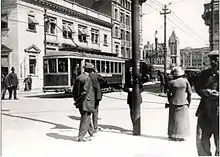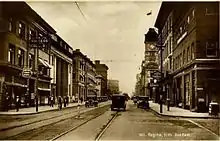Regina Municipal Railway
The city of Regina, Saskatchewan, operated a streetcar system, the Regina Municipal Railway, from 1911 to 1950.[1][2][3]


When introduced in 1911 four vehicles ran on a 10 kilometre route on 11th Street.[1][2] By 1913 the system had been expanded its fleet to 34 vehicles, and had added new routes on almost 30 kilometres of track.[4] Non-passenger vehicles used system to deliver coal and pick up trash.
Alan Artibise, in a chapter of Shaping the Urban Landscape: Aspects of the Canadian City-Building Process, described developers convincing the city to build streetcars routes "well past the limites of heavy settlement where little and often no housing existed."[5]
Thirty kilometers of track was to be the systems' largest extent. Regina shrank during World War I.[4] By 1920 fares had doubled from five cents to ten cents. The city was able to drop fares back down to five cents during the depression, but by 1931 only 20 kilometres of track remained in use.
In 1931 buses began to supplement the streetcar operations.[4]
Usage increased again during World War II when gasoline was rationed.[4]
A serious fire in the system's carhouse destroyed many of the system's vehicles in 1949, and the system was shut down a year later in 1950.[1][4]
References
-
Adriana Christianson (2015-06-11). "PHOTOS: Rebuilding Regina's 11th Avenue to remove streetcar tracks". CJME. Archived from the original on 2015-07-20.
According to the City of Regina website, the first four streetcars in Regina were introduced on July 28, 1911 just in time for the Regina Exhibition.
-
"Last remnants of Regina streetcars gone: The reconstruction of Albert Street between Hill and 23rd Avenues has meant the removal of a link to Regina's past". Regina Leader Post. 2008-08-05. Archived from the original on 2015-07-21.
“Another reason for adopting streetcars was because they confer a certain status on a city. This was the golden age of boosterism,” he added. “The streetcar was a symbol of progress and a symbol of Regina’s coming of age as a city.”
-
"Regina: The Early Years 1880 - 1950". University of Saskatchewan. Archived from the original on 2004-09-14. Retrieved 2015-07-21.
Not coincidentally, the streetcar lines all stopped directly in front of the R.H. Williams Department Store on 11 th Ave. . (Williams had been Mayor of Regina when City Council voted on where the streetcar lines should be placed.)
-
"Discover Regina Transit's History". City of Regina, Saskatchewan. Archived from the original on 2015-06-12. Retrieved 2015-07-20.
Saskatchewan was booming in 1911 and so was its capital city. Regina boasted a population of 30,000. The 4 streetcars put into service by the Regina Municipal Railway (RMR) on July 28, 1911 were proof that Regina was a modern and up-to-date city.
-
Gilbert Stelter (1982). "Shaping the Urban Landscape: Aspects of the Canadian City-Building Process". McGill-Queen's Press. p. 136. ISBN 9780773584860. Retrieved 2015-07-21.
In Regina, the municipally owned street railway system was under constant pressure by private real estate firms to build lines into areas "well past the limites of heavy settlement where little and often no housing existed." One result of the policy of creating streetcar suburbs was a loss of over $60,000 on the operation of the system in 1913, in addition to the service charges on the $1.5 million debt of the public street railway company in 1913. Yet the obvious lack of judicious planning apparent in the operation and expansion of the street railway system was contrasted with a situation in the city's foreign ghetto of Germantown, where 60 per cent of the houses lack such basic services as sewer and water connections.
External links
 Media related to Regina Municipal Railway at Wikimedia Commons
Media related to Regina Municipal Railway at Wikimedia Commons